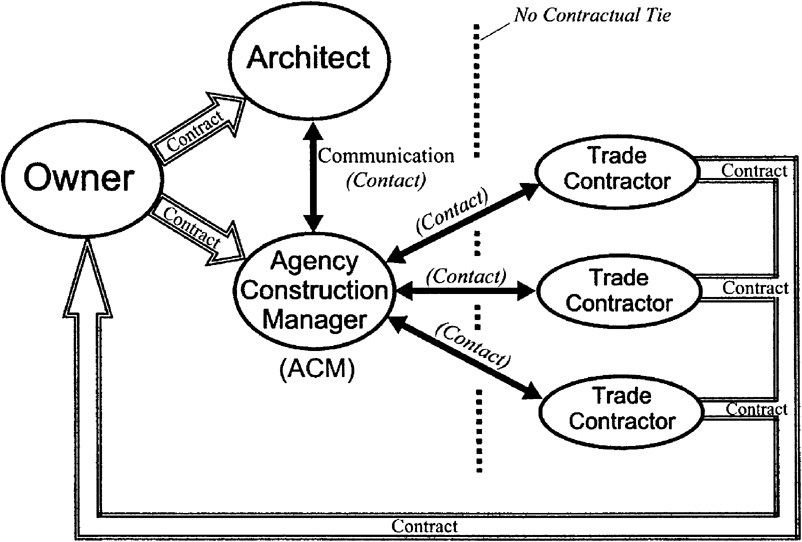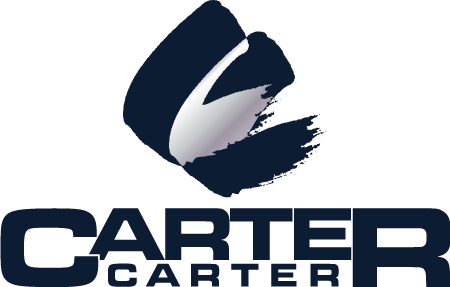“Construction Management” can mean many different things to different people. In a very real sense, every contractor is and always has been a “construction manager,” in that management regularly spends the bulk of its time orchestrating direct-hire labor, equipment, subcontractors, suppliers, and money (cash flow). Management “coordinates” the work with other contractors and outside requirements, plans and schedules the work, communicates the requirements to all parties, and does whatever it can to compel performance on the part of each individual player. Finally, the “contractor-construction manager” clearly documents each activity and develops skills for effective problem resolution.
* 3.2.11 Agency Construction Management (ACM)*
As the term is being used here, however, the functions and services (to the various extents as may be defined in the specific agency construction management agreement) are by design being carried out on behalf of the owner. An “agent” construction manager—the ACM—can be thought of essentially as an extension of the owner’s staff, with the assigned responsibility to manage the owner’s construction project. Somewhere along the line, the realities of the contractor-as-construction manager became apparent to construction owners. This thought soon became combined with the idea that if the owner were somehow able to manage the construction of his or her own project, the owner would also realize the benefits of the profit that otherwise would have been earned by a general contractor. As icing on the cake, the owner would also have the luxury of being able to directly control the “contractor” forces without otherwise assuming company-to-company liability for such direct intervention.
Refer to the preceding figure for illustration of the specific practical and contractual relationships in the Agency Construction Management arrangement. The agency construction manager (ACM) contracts directly with the owner to provide the distinct services in the consultant capacity. There is direct contact between the ACM and the individual trade contractors, much the same as in the general contracting sense, but there is no direct contract between the ACM and those trade contractors. There are usually not many “subcontractors” on ACM projects (if any at all) because the specialty contractors do not contract directly with the construction management firm. Instead, the specialty contractors are managed by the CM firm but formally contract individually with the owner. Because of this, they are generally referred to as “trade contractors.”
Because of the lack of any contractual tie between the ACM firm and each of the trade contractors, the ACM usually bears no direct liability for the performance or nonperformance of those trade contractors. Each of the individual trade contractors is—in contractual effect—a separate prime contractor because of its direct contractual relationship with the owner. The ACM firm manages each of the trade contractors essentially just as it would if it were a general contractor or “at risk” construction manager, but the important difference lies in the lack of direct contractual responsibility for performance.
Advantages of this method of project delivery can begin during the design phase. Input of construction expertise (provided by the ACM firm) early in the process—preferably during the concept stage—may significantly improve construction efficiencies further down the road. Through such involvement, the owner might ultimately obtain the same function of the project while actually reducing facility cost and operating expenses. Better knowledge of local construction sequences, conditions, and labor markets, etc., for instance, may significantly reduce total time needed for the design-construction process—thereby saving everyone money. An owner may benefit from a contractor’s superior working knowledge of sensible ways to format the various bid packages and apportion the work among the separate trade contractors. This kind of assistance can make it much easier to deal with the trades not only during the construction phase, but also through the management of callbacks and guarantee work. By being able to take a different look from a fresh perspective at the same “standard” specification sections and divisions and to impart professional judgment that can improve the effectiveness of the contract, direct cost savings, greater benefits for the same money, or both can be achieved.
Still another reason that owners have considered the ACM arrangement is to provide for the capability of “fast-tracking” the design and construction phases without losing control over the individual trade contract structures. In a fast-tracked environment, certain portions of the work can be bid, awarded, and begun at the site well before the entire facility design is complete. The foundation work can start while the structural steel design details are being finalized. Similarly, interior partitions can begin before the final wall finishes are selected. These individual bid packages are managed by the agency construction manager as their respective designs become finalized (or even “substantially” finalized). By being managed by the ACM on a fee basis, additional costs (caused to the trade contractors as a result of subsequent changes to previously completed designs) are passed back to the owner to pay for as change orders. Depending on the project, disposition of the owner, competency of both the design professionals and the ACM firm, and the manner of interaction among all of these companies, these types of problems can actually be minimized, and the benefits gained in the reduction in overall project time can more than offset any such increases in this type of direct cost.



Post your comment on this topic.